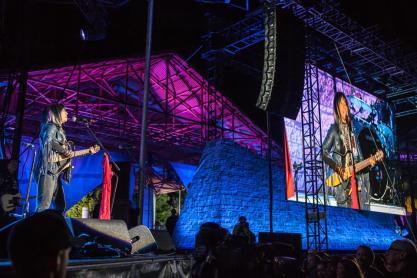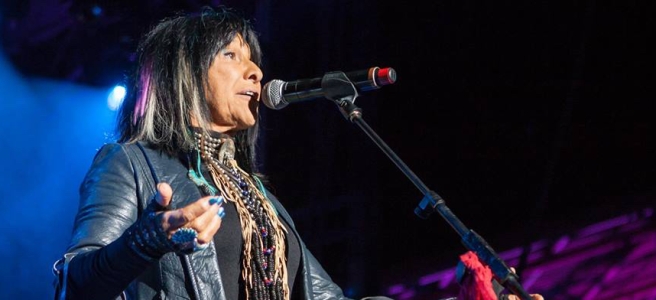Carly Ciufo
I was at The Forks in Winnipeg, Manitoba on September 20, 2014 for the opening of the Canadian Museum for Human Rights (CMHR). Working among colleagues who were both excited and anxious to finally open its doors, the day’s programming culminated in a concert headlined by some pretty heavy-hitting Canadian talent.
That afternoon, I was in the front lobby. I do not recall whether I was looking down at my phone or chatting with a co-worker to figure out where I could be useful on what was, of course, a busy day. Looking up, I caught a glimpse of this recognizably broad smile as she turned around and kept passing me by to prepare for the show later that night.
Folk singer. Rights activist. That powerhouse of a woman I have known through reputation all of my life.
There goes my first encounter with Buffy Sainte-Marie without having ever said a word.
I moved to Winnipeg in 2012 at a moment of transformation for both me and the city. With a newly defended MA under my belt, I had one goal in mind: strong-arm my way into the CMHR’s research department. I manoeuvred my way through my mom’s hometown, scoffing at critics of a museum that had yet to even open its doors when, through some elaborate mix of hard work and happenstance, I got there. I researched human rights events, transcribed oral histories, and cleared permissions for artist asset use throughout the galleries for nearly two years. And, with that, I had a front row seat to some sincere attempts of collaboration between museum professionals, culture creators, and affected community members both within and beyond the city limits.
Since 2000, almost everybody living in Winnipeg did.
My PhD subject of study was born in this environment. Of course, this moment in the city’s history is bigger than my personal narrative. What I can offer here, however, is an anecdote to the sociology that remains integral to the public history intersection where the academy, the heritage industry, and the museum audience meet. It is on this foundation that I have started to investigate the activist yet subversive relationship between Sainte-Marie and the CMHR.

The new Canadian history is about what current historians are uncovering in the depths of the archives with fresh questions, perspectives, and narratives. When we talk about the new Canadian history, however, we must also discuss what happens to the past outside of the university. I may now be drowning in books, archives, and documentaries, but I cannot escape my real-life memories of Winnipeg, Toronto, and Hamilton that instigated my library searches in the first place.
Exactly two years after the anecdote that opens this post, I was at Massey Hall watching the Art Gallery of Ontario’s inaugural Creative Minds panel on art and social justice. Alongside a sold-out crowd, I listened to Sainte-Marie, artist Rebecca Belmore, filmmaker Deepa Mehta, and author André Alexis discuss how their work speaks about and responds to various human rights issues. Nearing the end of the night, CBC Metro Morning host Matt Galloway asks a question about the upcoming sesquicentennial. “What are you thinking that we should be celebrating?” he asks Sainte-Marie.
Seated up in the balcony, I am thinking of my first encounter with Sainte-Marie when, without hesitation, she answers: “Stay calm and decolonize.” Massey Hall erupts in applause.
A couple of weeks later, Sainte-Marie stands at a podium in one of the classrooms at the CMHR. A few floors above, she is displayed as a human rights defender. Tomorrow, she will deliver a lecture discussing the Nihewan Foundation for Native American Education’s Cradleboard Teaching Project. Today, she will make nationwide news by demanding that the museum develop an adults-only residential schools exhibit.
A couple of days later, I am sitting in a downtown Hamilton lecture hall. Historian Matthew Hayday is speaking on “Constructing Canadian Identities: How Dominion Day and Canada Day Celebrations Have Shaped our Country” for the Wilson Institute’s fall speaker series. He mentions Sainte-Marie. Hayday is referring to the late 1970s Canada Day celebrations where live satellite technology projected cross-country events into living rooms nationwide. Sainte-Marie, he says, performed at Brokenhead Ojibway Nation in Treaty One territory, just northeast of Winnipeg. People across the country were tuning in.
Once again, Sainte-Marie is celebrated on another loosely state-proffered stage in ways paralleling those offered decades later by a museum supported by but separate from the federal government. Importantly, these experiences seem to have tainted neither her political activism nor her reputation.
Time and again, the Cree singer-songwriter uses state or state-adjacent platforms as spaces to challenge past and present indigenous policy. I wanted to know more about this, so I started to ask questions:
- Over her life, what has Sainte-Marie’s activism been based upon?
- How has she used the Canadian state?
- Has her activism ever muddled her message or the legitimacy of her indigenous voice?
- What are her connections to indigenous politicization throughout North America?
- Does her participation in Canada differ in any degree from her participation in the American Indian Movement (AIM)?
The life of Sainte-Marie has propelled her into a subversive role for defining Canadian identity while the country is celebrating, challenging, and negotiating itself on the eve of its 150th birthday. This, I insist, is exemplified in the exhibitions, performances, and lectures that she has collaborated on with the CMHR.
These ideas would not have come to me by reading books. I would not have thought to ask these questions if I never worked for a national museum. Expecting a discussion on art, artists, and social activism in Toronto, I would not have been schooled so directly on how artist-activists are approaching this year as Canadians if I did not take a coursework break to show up that night in the fall.
It became clear with my time in Winnipeg that the new Canadian history must interact with and relate to contemporary indigenous realities in the North End, on Portage Avenue, and at The Forks. These intersections define the living inheritance of our shared past put on display at a specific time and place in a transnational institution devoted to the human rights that we are all supposed to share.
What I am trying to get at is that important things happen when we dig ourselves out from the sometimes overwhelming pile of library stacks, microfilm material, and term papers. Stepping away not only gives further credence to academic validity and community affect; it also has the potential—as it has here for me—to inspire connections between the work that we do inside universities and the world outside of it.
Carly Ciufo is a doctoral student at McMaster University’s Department of History. Her dissertation will be a comparative study of human rights museums and the cities that build them, under the supervision of Ruth Frager and Ian McKay. After defending her MA thesis on the Catholic foundations of Québécois separatism at Queen’s University, she held multiple research, exhibit, and librarian positions at the University of Manitoba, the Canadian Museum for Human Rights, the Canadian Broadcasting Corporation, and the Canadian Museum of Immigration at Pier 21. Her project on Buffy Sainte-Marie will be presented twice in May. It will premiere at a panel discussion for the University of Toronto’s 13th Annual Graduate History Symposium: “Canada 150: Defining the Nation in a Transnational World.” She will then present at Ryerson University during the Annual Meeting for the Canadian Historical Association’s poster session, “From Far and Wide: The Next 150.”
Title Image: Buffy Sainte-Marie performing at the opening of the Canadian Museum for Human Rights. September 20, 2014. Photo credited to Matt Duboff.

One thought on “How to Find Subversive Canadians at 150”